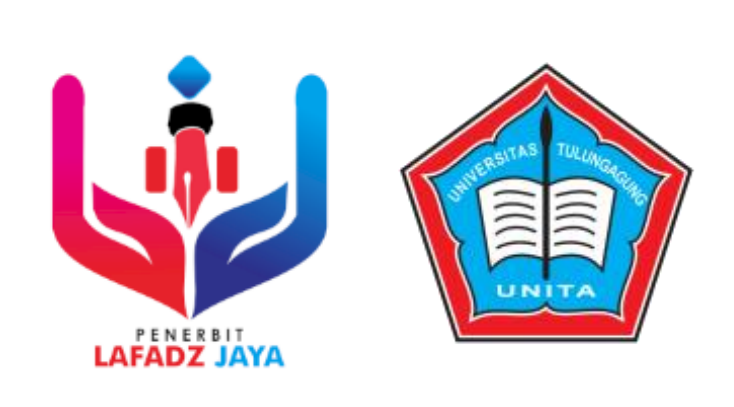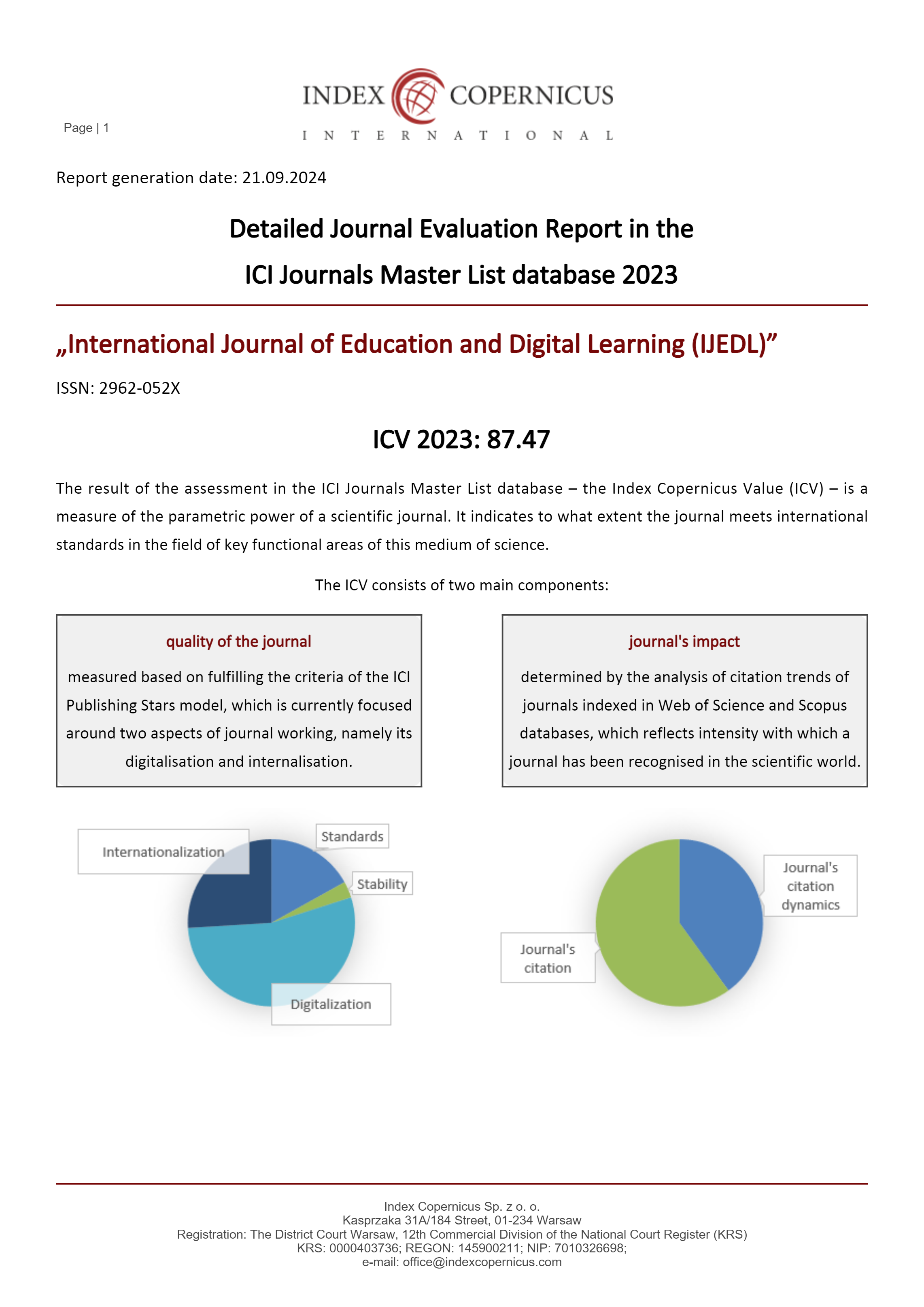Review of Instructional Digital Media to Path Teachers’ Digital Competence on Philosophical Perspective: Distraction or Diversion
DOI:
https://doi.org/10.47353/ijedl.v1i4.24Keywords:
digital media, instructional aid, teachers’ competence, digital competenceAbstract
In spite of its emergence in 1980s, digital media has been well known to this day, yet it is still questioned whether its presence is merely a "disturbance" or a "diversion" after contradictory impacts of digital media usage have been found based on several conducted studies. Answering the question, library research was carried out by using some sources and references in getting and analyzing the data. Then, the writers integrated their ideas by synthesizing in drawing conclusion. Delving into the essence of four learning theories (behaviorism, cognitivism, constructivism, and connectivism) and their integration with technology, particular media use and their functions are recognized through a systematic procedure in certain digital learning approach as one alternative for teachers in selecting and utilizing digital media in learning process. It was found that, firstly, the comprehension basic learning philosophy serves as fundamental reasons for teachers in utilizing technology. Secondly, the learning theories play as the base for teachers to develop their teaching approaches by maximizing their digital competence through digital technology use for improving their digital literacy. Lastly, the ownership of knowledge and skill for instructional digital media use develops teachers’ digital competence by recognizing students’ need in learning. In a nutshell, the choice for digital media utilization has to be supported by understanding the intensive relation between teachers and their learners’ roles and the instructional strategies in integrating media and technology used which will awaken not only teachers’ digital literacy, but especially their digital competence as well, as displayed through their ability to be intricately connected to digital media use. Therefore, the comprehensive understanding of learning theories approach of teachers and their ways in utilizing media-based technology determines the function of the media itself whether it is distraction or diversion during teaching and learning process.
Downloads
References
Abbasova, M., & Mammadova, N. (2019). The Role of Digital Technology in English Language Teaching in Azerbaijan. International Journal of English Linguistics, 9(2), 364. https://doi.org/10.5539/ijel.v9n2p364
Abd, A., Salih, A., Abd Allah Salih, A., & Sabah Elsaid, A. (2018). Students Attitude Towards the Use of Social Media for Learning Purposes (Case Study : Al-Baha University , College of Sciences & Arts- Biljurashi). Journal of Literature, Languages and Linguistics, 50(2006), 31–36. https://www.academia.edu/38173686/Students_Attitude_Towards_the_Use_of_Social_Media_for_Learning.pdf
Aesaert, K., Vanderlinde, R., Tondeur, J., & van Braak, J. (2013). The content of educational technology curricula: A cross-curricular state of the art. Educational Technology Research and Development, 61(1), 131–151. https://doi.org/10.1007/s11423-012-9279-9
Aisyah, S., & Haryudin, A. (2020). Instructional Media Used in Teaching English. PROJECT (Professional Journal of English Education), 3(6), 737. https://doi.org/10.22460/project.v3i6.p737-742
Ala-mutka, K. (2011). Mapping Digital Competence : Author : Kirsti Ala-Mutka. JRC European Commission, January 2011, 1–60. https://doi.org/10.13140/RG.2.2.18046.00322
Allam, M., & Elyas, T. (2016). Perceptions of Using Social Media as an ELT Tool among EFL Teachers in the Saudi Context. English Language Teaching, 9(7), 1. https://doi.org/10.5539/elt.v9n7p1
Almarabeh, H., Amer, E. F., & Sulieman, A. (2015). The Effectiveness of Multimedia Learning Tools in Education. International Journal of Advanced Research in Computer Science and Software Engineering, 5(12), 761–764.
An, Y. (2019). History of Instructional Instructional Design , and Theories Media , To cite this article : of A History of Instructional Media , Instructional Design , and Theories. International Journal of Technology in Education, 4(1), 1–21.
Anggeraini, Y., Faridi, A., Mujiyanto, J., & Bharati, D. A. L. (2019). The teachers’ perceptions on digital literacy competences in EFL classroom. Asian EFL Journal, 24(4), 5–12.
Anna, Arlin, R. (2022). Pemasaran Era Kini : Pendekatan Berbasis Digital (Issue February).
Buzzetto-More, N. (2008). Student Perceptions of Various E-Learning Components. Proceedings of the 2008 InSITE Conference, January 2008. https://doi.org/10.28945/3204
Calvani, A., Cartelli, A., Fini, A., & Ranieri, M. (2008). Models and Instruments for Assessing Digital Competence at School. Journal of E-Learning and Knowledge Society, 4(3), 183–193. https://doi.org/10.20368/1971-8829/288
Chu, H. (2015). Research methods in library and information science: A content analysis. Library and Information Science Research, 37(1), 36–41. https://doi.org/10.1016/j.lisr.2014.09.003
Foulger, T. S., Graziano, K. J., Schmidt-Crawford, D. A., & Slykhuis, D. A. (2017). Teacher educator technology competencies. Learntechlib.Org, 25(4), 413–448. https://www.learntechlib.org/p/181966/
Gana, M., Haryanto, & Salija, K. (2018). Teachers’ Strategies in Teaching Speaking (a Case Study of an English Teacher in Sma Negeri 1 Toraja Utara). Teachers’ Strategies in Teaching Speaking, 1–10.
Harmoko, D. D. (2021). Digital Literacy As A Solution To Improve The Quality Of Indonesia’s Human Resources. Research and Development Journal of Education, 7(2), 413. https://doi.org/10.30998/rdje.v7i2.10569
Huff, A. S. (2016). Project Innovation | PMI. August. https://www.pmi.org/learning/library/project-innovation-11633
Instefjord, E. (2015). Appropriation of digital competence in teacher education. Nordic Journal of Digital Literacy, 2015(4), 155–171. https://doi.org/10.18261/issn1891-943x-2015-jubileumsnummer-11
Iwuoha, J. C. (2020). Electronic Research Journal of Social Sciences and Humanities ISSN: 2706 – 8242 www.eresearchjournal.com Vol. Covid-19: Challenge to SDG and Globalization, 2(III), 103–115.
Jan, H. (2017). (PDF) Teacher of 21 st Century: Characteristics and Development. Research on Humanities and Social Sciences, 7(9), 1–6.
Janssen, J., Stoyanov, S., Ferrari, A., Punie, Y., Pannekeet, K., & Sloep, P. (2013). Experts’ views on digital competence: Commonalities and differences. Computers and Education, 68, 473–481. https://doi.org/10.1016/j.compedu.2013.06.008
Jerslev, A. (2014). New media talk - An introduction. Northern Lights, 12(1), 3–9. https://doi.org/10.1386/nl.12.1.3_7
Koç, M. (2005). Implications of Learning Theories for Effective Technology Integration and Pre-service Teacher Training : A Critical Literature Review. Journal of Turkish Science Education, 2(1), 2–18.
Letters, I. S. (2023). The Convergence of Traditional Media to the Digital Communicative Environment- The Reality and Gap. Information Sciences Letters, 12(4), 1827–1839. https://doi.org/10.18576/isl/120408
Levin, T., & Wadmany, R. (2006). Teachers’ beliefs and practices in technology-based classrooms: A developmental view. Journal of Research on Technology in Education, 39(2), 157–181. https://doi.org/10.1080/15391523.2006.10782478
LUMSDAINE, A. A., & MAY, M. A. (1965). Mass Communication and Educational Media. Annual Review of Psychology, 16, 475–534. https://doi.org/10.1146/annurev.ps.16.020165.002355
Mattar, J. (2018). Constructivism and connectivism in education technology: Active, situated, authentic, experiential, and anchored learning. RIED. Revista Iberoamericana de Educación a Distancia, 21(2), 201. https://doi.org/10.5944/ried.21.2.20055
Maysarah, A., Rahim, R., & Wahyuni, D. (2020). Media Sosial Dan Media Sosial Dalam Pembelajaran Bagi Siswa / Siswi Smk Negeri 5 Medan. Reswara: Jurnal Pengabdian Kepada Masyarakat, 1(1), 1–11.
Ng, W. (2012). Can we teach digital natives digital literacy? Computers and Education, 59(3), 1065–1078. https://doi.org/10.1016/j.compedu.2012.04.016
Ngulube, P. (2015). Qualitative data analysis and interpretation: systematic search for meaning. Addressing Research Challenges: Making Headway for Developing Researchers, June, 131–156. https://doi.org/10.13140/RG.2.1.1375.7608
Nguyen, L. A. T., & Habók, A. (2023). Tools for assessing teacher digital literacy: a review. In Journal of Computers in Education (Issue December 2022). Springer Berlin Heidelberg. https://doi.org/10.1007/s40692-022-00257-5
Nyayu, S. Y., Heru, S., & Masagus, S. (2019). the Use of Technology Integration Samr Model in Teaching English. IDEAS: Journal on English Language Teaching and Learning, Linguistics and Literature, 7(1), 1–5. https://doi.org/10.24256/ideas.v7i1.720
Pagani, L., Argentin, G., Gui, M., & Stanca, L. (2016). The impact of digital skills on educational outcomes: evidence from performance tests. Educational Studies, 42(2), 137–162. https://doi.org/10.1080/03055698.2016.1148588
Pendit, P. L. (2013). Digital Native , Literasi Informasi dan Media Digital – sisi pandang kepustakawanan. Seminar Dan Lokakarya Perubahan Paradigma Digital Natives Perpustakaan Universitas - Universitas Kristen Satya Wacana Salatiga 17 - 18 Januari 2013, 1–32. https://www.semanticscholar.org/paper/Digital-Native%2C-Literasi-Informasi-dan-Media-%3A-sisi-Pendit/1ed653f61ce6ce178dee0cb255419d0492a92afc
Potter, W. J. (2010). The state of media literacy. Journal of Broadcasting and Electronic Media, 54(4), 675–696. https://doi.org/10.1080/08838151.2011.521462
Pujasari Supratman, L. (2018). Penggunaan Media Sosial oleh Digital Native. Jurnal Ilmu Komunikasi, 15(1), 47–60.
Readings, S. (2008). Unit 3 Learning Theories : Implications for Ict. 53–69.
Røkenes, F. M., & Krumsvik, R. J. (2014). Development of student teachers’ digital competence in teacher education. Nordic Journal of Digital Literacy, 2014(4), 250–280. https://doi.org/10.18261/ISSN1891-943X-2014-04-03
Shadiev, R., & Yang, M. (2020). Review of studies on technology-enhanced language learning and teaching. Sustainability (Switzerland), 12(2). https://doi.org/10.3390/su12020524
Shevchenko, M. (2017). Multimedia as an ESP teaching aid at technical universities. ScienceRise: Pedagogical Education, 0(4 (12)), 4–8. https://doi.org/10.15587/2519-4984.2017.100042
Sindi Alivi, J. (2019). a Review of Tpack and Samr Models: How Should Language Teachers Adopt Technology? Journal of English for Academic and Specific Purposes (JEASP), 2(2), 1–11. https://doi.org/10.18860/jeasp.v2i2.7944
Smaldino, S. E., Lowther, D. L., & Mims, C. (2012). Instructional Media and Technology for Learning. International Journal of Distributed and Parallel Systems, 3, 8.
Tam, M. (2000). Constructivism , Instructional Design , and Technology : Implications for Transforming Distance Learning & RQVWUXFWLYLVP , QVWUXFWLRQDO ’ HVLJQ DQG 7HFKQRORJ , PSOLFDWLRQV IRU 7UDQVIRUPLQJ ’ LVWDQFH / HDUQLQJ. Educational Technology & Society, 3(2), 50–60.
Tanggoro, U. (2015). the Use of Instructional Media To Improve Students’ Motivation in Learning English. Urip Tanggoro 100 Dialektika Journal, 3(1), 100–107.
Wahyuni, S., Mujiyanto, J., Rukmini, D., & Fitriati, S. W. (2020). Teachers’ Technology Integration Into English Instructions: SAMR Model. 443(Iset 2019), 546–550. https://doi.org/10.2991/assehr.k.200620.109
Wulandari, A. P., Salsabila, A. A., Cahyani, K., Nurazizah, T. S., & Ulfiah, Z. (2023). Pentingnya Media Pembelajaran dalam Proses Belajar Mengajar. Journal on Education, 5(2), 3928–3936. https://doi.org/10.31004/joe.v5i2.1074
Yana, D., & Darwati, F. F. (2018). The Implementation of Android-Based Application as a Media for Teaching English in Simple Present Tense. ANGLO-SAXON: Jurnal Ilmiah Program Studi Pendidikan Bahasa Inggris, 8(2), 158–165. https://doi.org/10.33373/anglo.v8i2.1215
Yanti, G. S., & Nurhidayah, R. (2020). Practices on Technology Integration in ELT: A Review on Existing Researches. Briliant: Jurnal Riset Dan Konseptual, 5(2), 292. https://doi.org/10.28926/briliant.v5i2.467
Downloads
Published
How to Cite
Issue
Section
License
Copyright (c) 2023 Syofianis Ismail, Zhang Ling, Erna Nawir, Alber Alber, Desna Fauziah

This work is licensed under a Creative Commons Attribution 4.0 International License.













